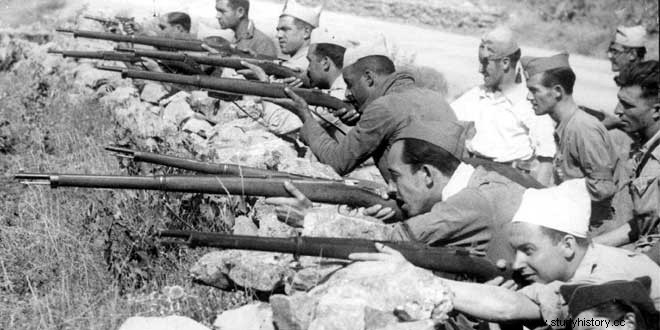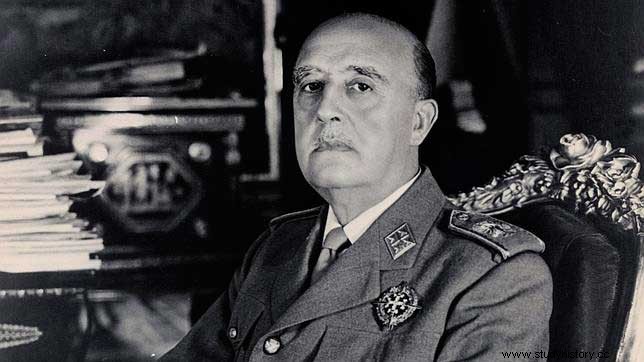Francisco Franco Bahamonde (1936-1975). Head of state. He was born on December 4, 1892 in El Ferrol (La Coruña). On August 29, 1907, he entered the Infantry Academy, where he became a second lieutenant on July 13, 1910, a first lieutenant in 1912, a captain in 1914, and rose through the ranks until he reached division general in March 1934. When Commander Millán Astray founded the Legion, he called him to send the first flag in 1920 . Many of his services were rendered in Morocco. He was appointed director of the General Military Academy of Zaragoza, where he remained until this Academy was closed in the spring of 1931 by a decree of Manuel Azaña (then Minister of War in the Government of the Second Republic). On May 14, 1935, he was appointed chief of the Central General Staff by José María Gil-Robles (Minister of War and head of the CEDA).
Military uprising
After the Popular Front came to power in February 1936, a group of soldiers planned an army uprising against the Government of the Republic; but, as soon as Azaña became president of the Republic on May 10 of that same year, he removed certain suspicious generals from Madrid, among whom was Francisco Franco, who was sent to the Canary Islands; but the plan for the military uprising was already outlined. Public order went from bad to worse:looting, fires, murders, etc.; Lieutenant José del Castillo was assassinated on July 12, 1936, and José Calvo Sotelo the following day; but, since the 11th, an English civil plane, the Dragon Rapide (piloted by Captain Bebb), was already waiting for Franco in Las Palmas. Finally, the military uprising began on the 17th in the Boundary Commission, in Melilla, and in the Mountain Barracks of the 36th Horse Artillery Regiment, in Carabanchel, Madrid, commanded by General Fanjul; but here the uprising failed; The barracks was surrounded, from the beginning of the 20th, by the militiamen who fired at it from all sides, while the Republican aviation of Cuatro Vientos bombarded it for more than fifteen hours, until the resistance was suffocated; then the republican officers and the assault guards entered the ruins, and arrested, among others, generals Fanjul and Fernández Quintana.
Francisco Franco uprising
On July 17, 1936, Franco left Santa Cruz de Tenerife and arrived in Las Palmas. On the 18th, the army revolted against the Government of the Republic in various parts of the Peninsula:General Mola in Navarra, Queipo de Llano in Seville, Cabanellas in Zaragoza, etc . General Franco left Las Palmas on this day in the Dragon Rapide and made a stopover at Casa Blanca; on the 19th, he continued his flight to Tetouan, where he took command of the troops from Africa (the Legion and the Regulars); On this date, General Goded, military governor of Majorca, arrived in Barcelona to lead the rebel army in Barcelona; but, due to arriving late, he was arrested (later they shot him on August 12 of that same year), with which the uprising in Barcelona was frustrated; On this same day, the 19th, rebel troops left Pamplona to enter Madrid, which they could not achieve; therefore, the uprising failed in the two most important cities:Madrid and Barcelona; but, on this day, the civil war was already established between the rebels and the republicans .

Franco's arrival on the peninsula
General Franco crossed the Strait of Gibraltar with his army on the following August 6 and controlled Lower Andalusia and immediately also Badajoz; so, in the first fortnight of August, the Spanish territory was divided between republicans and rebels , they controlled the following provincial capitals:Cádiz, Huelva, Seville, Granada, Córdoba, Badajoz, Cáceres, Avila, Salamanca, Zamora, Orense, Pontevedra, Lugo, La Coruña, León, Palencia, Valladolid, Segovia, Burgos, Vitoria, Pamplona , Logroño, Soria, Huesca, Zaragoza, Teruel, Palma de Mallorca, the Canary Islands and all the Spanish territories in Africa; the rest of Spanish territory remained under the control of the Government of the Republic, which handed over arms to the trade union organizations and the popular masses; but only 20% of the military commanders remained (a part of them went to the rebel zone).
Appointment as head of state
General Sanjurjo, head of the rebel army, died in a plane crash (some think it was an attack) at the very beginning of the conflict, on July 20, 1936; so the heads of the rebel army, meeting in Burgos, named Franco "Generalissimo and Head of State" , appointment published in the Official State Gazette on September 20 of that same year. Thus General Franco assumed the leadership of the war and of the government in the area controlled by his army; This was expanded until he controlled the entire territory of Spain.
End of war
he took the city of Madrid on March 28, 1939; the last capital of the province taken was Alicante on the 31st of the same month, with which the end of the war was announced on April 1, 1939; then, the Second Republic, which had begun with municipal elections, ended with a civil war that lasted almost three years.
In September 1936, under the Government of the Second Republic, seven hundred tons of gold were taken from the Bank of Spain, in Madrid, to the Cartagena naval base; from there, that gold was transported by ship to Odessa, from where it traveled by train to Moscow.
Important events during the franco government
After the war, General Franco continued to rule Spain until his death on November 20, 1975 in Madrid . Once the civil war ended, the institutions of the Second Republic (Presidency and Government) continued to exist in exile until they self-dissolved on June 21, 1977.
During the government of General Franco, Spain declared itself neutral at the start of World War II in 1939 . In 1950, Spain joined the FAO; in 1951 at the ONS; in 1952, at UNESCO; in 1953, the signing of an agreement with the United States gave rise to the establishment of American military bases in Rota, Torrejón and Zaragoza; In 1955, Spain joined the UN. On Sunday, October 28, 1956, TVE began operating on Paseo de la Habana (Madrid). In this same year, the independence of Morocco was recognized, as well as that of Guinea in 1968. On September 2, 1963, the Court of Public Order was created with headquarters in the Palacio de las Salesas, in Madrid. This court dealt with crimes against the Head of State, against the Government, the Fundamental Laws, terrorism, etc.

